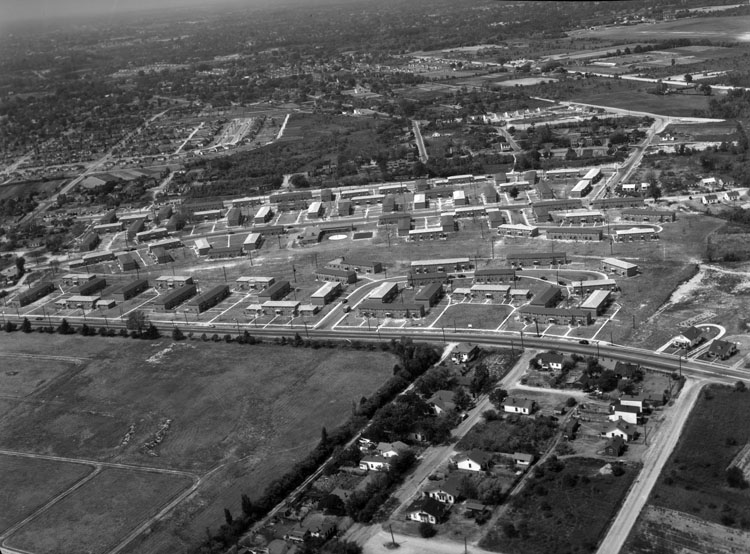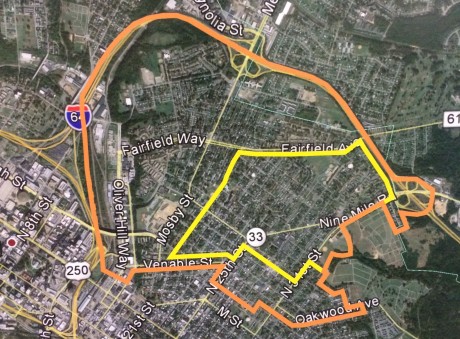RECENT COMMENTS

The future of public housing in Richmond
More than 100 people turned out for the 3rd in a series of public meetings on the North Church Hill revitalization project at Woodville Elementary School last night, with at least 1/4 of those in attendance residents of the area public housing.
While the Pear Street and Dock Street projects have grabbed plenty of attention, the North Church Hill revitalization effort is somehow seemingly coming in under the radar. This is something of a surprise, as this project will have the larger long-term impact on the East End. A success with Creighton Court will be the blueprint for re-thinking all of the city’s public housing.
The plan at its core is to redevelop the Creighton Court public housing community as a mixed-income community, with the broad goals of seeing improvement in schools, safety in the community, resident health, and economic development.
The 504 units of Creighton will be replaced with 1200 mixed-income units. At least 900 of the replacement units will be in the East End (within the orange boundaries on the map below). Construction is tentatively slated to begin in late 2015.
A recurring note struck by almost every speaker last night was the need for residents of the public housing communities to take their part in the planning process. Mayor Jones described the need ensure that “the future is not something that is done to you, but with you and for you.”
The Community Builders’ Rob Fossi described the 4 key principles of what he stressed had to be a “resident-driven initiative” as:
- 1-for-1 replacement of existing public housing units
- build first
- true mixed income community
- right to return
There was some back-and-forth at one point between residents in the audience and RRHA representatives concerning the 1-for-1 replacement and the right of return. The replacement guarantees that each of Creighton’s 504 public housing units will be replaced with another public housing unit with the exact same criteria for residency.
The right of current residents to return to the community comes with caveats. “Non-lease compliant residents” will have to be in good standing to have the opportunity to move back The RRHA’s Adriene Goolsby said that they are starting now, “eighteen months, two years out to get residents compliant.”
There are 2 information sessions scheduled for next week local residents. The first will be held Monday April 28th 5-6 PM at Anna Julia Copper School at 2124 North 29th Street; the second will be Thursday May 1, also 5-6 PM, at Peter Paul Development Center at 1708 North 22nd Street.
Photo: Creighton Court (1953) via Adolph B. Rice Studio at the Library of Virginia







It looks to me like we are going to tear down a ton of units and put them back in almost the exact same place. I don’t see this accomplishing anything. I wish this plan well but don’t believe in it because all I see us accomplishing is newer prettier buildings. I do think that the City does have some very smart people who are working on this. People who are studying past failures and working towards creative solutions. So I don’t want to be a downer. Putting most of these units back in the same place will not accomplish a mixed income community so I would love to hear how the developer intends to attract middle and upper income prospective tenants. (That said, I didn’t attend the meeting so they may have that covered. Just didn’t see it in this article)
Well said #3. This makes sense to invest in only if we are expecting different results. Otherwise it’s just throwing another log on concentrated poverty fire.
The easy part is how to attract residents who basically have no alternatives and the hard part, which seems to only get lip service in these discussions, is how to attract middle class residents to live in the middle of a project.
Why are these “replacement” units not being distributed throughout the city? This is still largely concentrated in the East End. Concentrated poverty will still have a negative impact on the city. What efforts are in place or proposed to “wean” these folks off of public housing?
I think Mayor Jones quote epitomizes the city’s attitude towards the issue quite well:
“…the future is not something that is done to you, but with you and for you.”
Sadly missing is the most important part about “by you.” I know many of these people want to improve but rarely do we see solutions that focus on giving the less fortunate the tools to improve. It always seems the approach is to maintain the status quo of keep these folks comfortable but dependent.
Public housing should be temporary, just a means to getting back on one’s feet. The system today encourages dependency & stagnation. Ridiculous, and yes I can see those middle class residents lining up to live in the middle of the projects.
Until taxpayers say ‘no more’ it’s going to be business as usual.
One of the little-known facts about public housing in Richmond is that Charles F. Gillette, the father of the “Virginia Garden” was the author of much of the plantings in these projects. Where Gillette once designed gardens for the elite of Windsor Farms, after the war he was taking work where he could get it. Public housing and the Bell Atlantic telephone company were clients that provided work for the distinguished landscape designer.
Public housing is necessary in every thriving city to provide some social mobility and provide an opportunities for families to become one of the middle class.
True it is meant to be temporary but like everyone else in the city the residents are caught in the political agendas of RRHA and the mayor. These people are used as nothing more than chattel, by maintaining a class of poverty they keep jobs and give themselves bonuses all while getting praise for keeping the poor out of our neighborhoods.
The system is broken and it starts with a new mindset only time will tell if this is a real solution.
I agree with a few of the comments above, most of all though I think there should be a process in place to make the housing transitional, safe and durable.
By transitional, I mean these houses should be a place where a family gets a specific amount of time to move in and have a stable place to live while working on some form of job training in a field that is in demand. Additionally there could be a few jobs that could be offered to some of the other people that have transitioned out such as providing supplemented child care for others still in the system.
I also believe that they east end should have a proportional amount of the houses. I am sure that there are plenty of empty lots in the area, but part of the problem with redevelopment in the area has been the concentration of units in east end.
These units should be well built and safe. By well built, I mean not just handed off to the lowest builder. The units should be built using commercial grade fixtures to ensure they last as long as possible. By safe I mean not just thrown in an area out of the way off by itself. These houses need to be along bus lines where possible. They also need to be located near centers of employment where possible.
We should restrict the homes to a few designs that fit the Richmond area and build 2 of each in some experimental areas. There are vacant lots in develop parts of the entire city.
I also think that we should make the section of housing that is located kitty corner to the Leigh street viaduct the first section to come down. This is for a couple of reasons.
The first is that it is the first thing people see when they come across the bridge from downtown. If we are going to change the false perception that the area is completely destitute, we need to start with the entrances to this part of town.
The second reason is that this area is ripe for mixed use development. In a section of town where the majority of current buildings fit some kind of historical niche, this is an area where a building designed to match some of the historical features of the area would be perfect for commercial use on the lower floors and residential units on the upper floors. Being right across the viaduct from the hospital, there would be a built in group of residents many of which will currently not cross the bridge.
A building with a grocery store on the bottom (say a Wegman’s) would be perfect. It would also bring some employment to the area itself. A nice 12 story building would give the place some really nice views and be tall enough to get the attention of drivers travelling along 95 and help change the perception of the area.
I know there is a lot of resistance to losing the character of the neighborhood and I certainly understand it. So it would require all of us to be vigilant of what is being developed. But it would beat what is there now. A couple of units could be set aside for low income disabled since the building would meet all the new codes for accessibility anyways. Also, is could tie in with some of the plans for Mechanicsville Turnpike, 9 Mile Rd and 25th street.
Public housing and redevelopment do not have to be dirty words, they just need to closely watched.
Input on what gets built has been elicited from those who will eventually live in the units. Many of these people have called for at least 4 bedrooms and in-law suites.